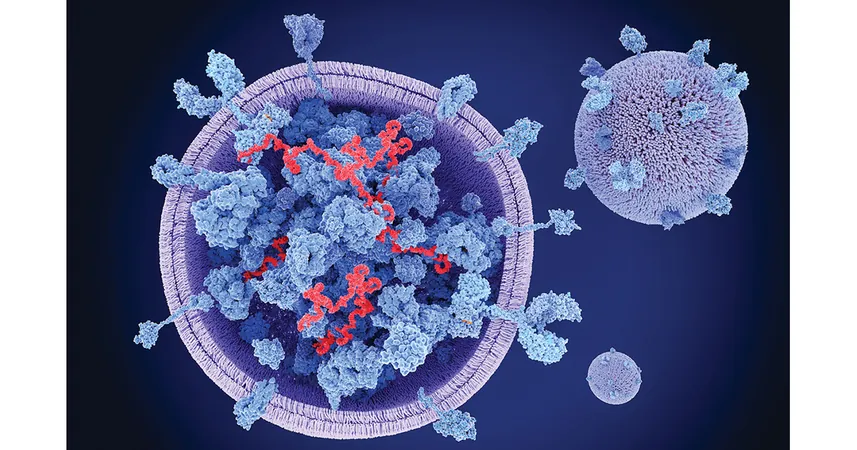
Meet 'Conan the Bacterium': The Radiation-Resistant Microbe Inspiring Revolutionary Antioxidants for Human Protection
2024-12-16
Author: William
Exciting new research unveils how an extraordinary bacterium, known as **Deinococcus radiodurans**, or "Conan the Bacterium," could pave the way for groundbreaking advancements in human protection against radiation, both on Earth and in the depths of space.
This extreme microbe has captured the world's attention due to its astonishing resilience to radiation levels thousands of times greater than what would be fatal for humans. Unlike most life forms that succumb to intense radiation exposure, D. radiodurans possesses unique adaptations that allow it not just to survive, but to thrive in environments hostile to life.
Understanding the Dangers of Ionizing Radiation
Michael Daly, a prominent geneticist specializing in D. radiodurans at the Uniformed Services University in Maryland, explained, "Ionizing radiation, like X-rays and gamma rays, is lethal to both bacteria and humans." For bacteria, exposure can lead to catastrophic DNA damage, disrupt essential cellular processes, and ultimately result in cell death. In humans, risks include severe acute radiation syndrome and long-term effects like increased cancer susceptibility and organ damage.
How 'Conan' Outsmarts Radiation
What fuels D. radiodurans' remarkable resistance? Its protective cell wall, superior DNA repair mechanisms, and a special arsenal of antioxidants that neutralize reactive free radicals—unstable molecules that wreak havoc at the cellular level.
In a study recently published in *Proceedings of the National Academy of Sciences (PNAS)*, researchers, including Daly and his team, set out to harness the power of one potent antioxidant produced by this resilient bacterium. This journey led them to develop a synthetic variant of the antioxidant, designated as **manganese-dependent peptide (MDP)**.
The 'Secret Sauce' Behind MDP
This new antioxidant is crafted from a combination of charged manganese ions, phosphate ions, and a specialized peptide inspired by the amino acids prevalent in D. radiodurans. Co-author Brian Hoffman, a chemistry professor at Northwestern University, initially doubted the effectiveness of MDP, believing it was merely a composite of its parts. To his surprise, he discovered that the synergy created a holistic compound that outperformed expectations—a revelation he describes as the compound's "secret sauce."
Testing indicated that this ingenious structure could endure over 12,000 times the lethal dose of ionizing radiation for humans, opening exciting pathways for practical applications.
Radiation Protection for Space Explorers and Earthlings
The potential applications of MDP are staggering. As astronauts embark on extended missions to Mars, where exposure to cosmic rays and solar protons poses serious health risks, MDP could serve as a *cost-effective, non-toxic solution* to safeguard their health. Given that future crewed missions could last over a year, incorporating such protection becomes crucial.
On Earth, the implications of MDP may stretch even further, potentially offering protective measures against acute radiation syndrome and contributing to the fight against metabolic aging—a process closely linked to radiation exposure.
However, researchers emphasize that further studies are necessary to develop safe and effective formulations of MDP for human use. As research progresses, it's conceivable that the incredible resilience of D. radiodurans will not just stay confined to the microscopic realm but will evolve into revolutionary protection for human health and safety.
For explorers of all kinds, the future is shining ever so brightly thanks to the remarkable "Conan the Bacterium."









 Brasil (PT)
Brasil (PT)
 Canada (EN)
Canada (EN)
 Chile (ES)
Chile (ES)
 España (ES)
España (ES)
 France (FR)
France (FR)
 Hong Kong (EN)
Hong Kong (EN)
 Italia (IT)
Italia (IT)
 日本 (JA)
日本 (JA)
 Magyarország (HU)
Magyarország (HU)
 Norge (NO)
Norge (NO)
 Polska (PL)
Polska (PL)
 Schweiz (DE)
Schweiz (DE)
 Singapore (EN)
Singapore (EN)
 Sverige (SV)
Sverige (SV)
 Suomi (FI)
Suomi (FI)
 Türkiye (TR)
Türkiye (TR)